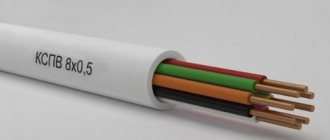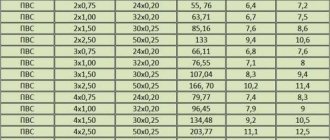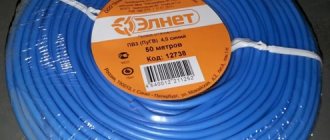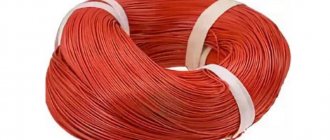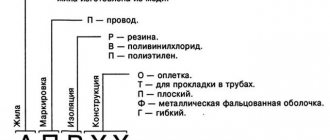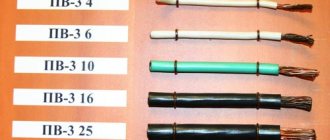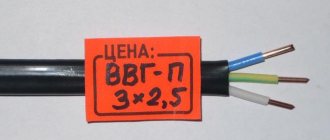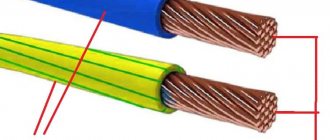Wire PuGV 1x6 is a power installation cable; a conductor consisting of several wires made of copper is used as a conductive element. The insulating layer is represented by PVC compound with various pigmentations. The shades used are white, blue, yellow-green, brown, red, gray, blue, black.
The product is standardized by state standard 31947-2012. In OKPO it has code 355113.
Navigation
- Decoding
- Features and Benefits
- Application
- Wire design
- Specifications
- How much does it weigh?
- Price
- Wire installation
Return to navigation
Features and Benefits
The modern range of wires is represented by high-quality products with such advantages as ease of installation, reliability during operation, etc. It is these properties that characterize PuGV 1x6. Currently, the cable is most widely used in the construction of power transmission lines and communication networks. The advantages of the wire also include increased flexibility and durable PVC insulation. During installation, direct exposure to ultraviolet radiation on the cable should be avoided.
To facilitate the work of electricians, various options for painting the product are provided. This eliminates confusion when laying multiple wires, repairing and replacing them. When constructing complex networks, this advantage is the most significant. All manufacturing plants have their own color spectrum of polyvinyl chloride coating, because... regulatory documents have no restrictions on their design. Most often, the wires are solidly colored in one shade, with the exception of the yellow-green cable, in which the yellow and green stripes are arranged diametrically. This provides additional convenience when indicating grounding. The zero phase is most often laid with a blue cable.
PuGV 1x6 wire should be stored in closed warehouses that exclude exposure to ultraviolet radiation and high humidity.
The resistance under normal conditions is 1 MOhm/km when accepting work and transporting the product, and 0.01 MOhm when working and in warehouses.
PuGV 6 is wound on a drum or assembled into a bay. The standards do not provide requirements for the diameter of the auxiliary unit for transportation. Behind the scenes, drums and couplings with a winding element with a diameter equal to ten outer diameters of the cable are used. These elements contain a tag with information about the manufacturer, cable designation, product length, gross weight in kg (drums), production time and regulatory support.
Return to navigation
Application
Wire PuGV 1x6 mm2 is used in non-mobile networks with voltage less than 0.75 kV and frequency less than 0.4 kHz. The product is most widely used when installing power supply systems in lighting and power circuits, as well as when switching devices in power panels.
It is mounted inside steel pipes, boxes, trays, and can be used when constructing highways with increased requirements for cable flexibility.
A single cable does not spread fire.
Return to navigation
Decoding and design of the PuGV wire
In order to understand what PuGV is, let’s take a detailed look at the decoding of its name. And then we’ll try to understand the features of its design and varieties.
Decoding the marking of the PuGV wire
Let's start our analysis by deciphering the name. After all, no matter how it is, it is in it that the main parameters of the wire are hidden. And understanding this abbreviation should already give us an understanding of the design of the wire.
Decoding wire markings
So:
- Our first symbol is “Pu” . They mean that we have an installation wire in front of us. Previously, wires were divided into installation and installation. Installation wires were called less flexible wires, and installation wires were more flexible. There were other differences, but these are the main ones. Now they decided to call all the wires installation ones.
Wire flexibility classes
- But the flexibility of the wire still needs to be determined. Therefore, we decided to introduce the symbol “G” , which indicates that the wire is flexible. If this symbol is not present, it means that the wire is not flexible. The symbol “G” is assigned to all wires belonging to the fifth class of flexibility according to GOST 22483 - 2012.
- The last character is "B" which indicates the type of insulation. In our case, this is vinyl insulation or, as it is more correctly called, polyvinyl chloride. In addition, the abbreviation may contain another letter “B”. It indicates the presence of a shell and indicates the material of this shell. But this is a different type of wire.
- The last symbol that can be in the abbreviation is the fire safety indicator of the wire. Moreover, if this abbreviation is not present, it means that the cable does not propagate combustion when laid alone. If the symbol “ng” appears, it means the wire does not spread flame when laid in groups.
In addition, for wires with the designation “ng”, GOST assumes the possibility of having some more symbols. So “LSLTx” speaks of reduced dust and gas emissions during combustion.
The “HF” symbol indicates that the cable does not emit corrosive gases when burned. Well, the “HFLTx” symbol demonstrates that the wire, when burned, emits little dust, gas and corrosive substances.
Various cross-sections of PuGV wires
The abbreviations are usually followed by numbers. Usually this is one number from 0.5 to 240. It indicates the cross-section of the current-carrying part of the wire. And only in rare cases can you find the symbols “1x1” or the like, in which the first digit indicates the number of cores, and the second the cross-section of the current-carrying part of the wire.
Wire design PuGV
Now we can talk about the design of the wire itself. As we have already mentioned above, PuGV wires are single-core and due to this their design is quite simple.
So:
- First of all, it is a conductor, which consists of several copper wires. Individual wires of smaller cross-sections twisted together make it possible to ensure proper flexibility of the wire even with a large total cross-section.
- The number of these individual wires depends on the cross-section of the cable. So for wires with a cross-section from 0.5 mm2 to 35 mm2, the minimum number of wires is 7 pieces. But usually for larger diameters there are more of them and their number is determined by the technical regulations of each individual manufacturer.
- For wires with a cross-section from 50 mm2 to 95 mm2, the instructions provide for the use of at least 19 wires. And for larger cross-section wires there are 37 wires.
- But this is the minimum value. The actual value can be found out based on the cross-section of each individual wire. After all, it is quite logical here that the smaller the cross-section of each individual wire, the greater their number will be required in order to obtain the required nominal cross-section of the wire.
- And here standards come to our aid again. So for a wire with a cross-section of 0.5 mm2, the cross-section of each individual wire should be no more than 0.21 mm2. For a wire with a cross-section of 10 mm2 this value should already be no more than 0.41 mm2, and for a wire with a cross-section of 240 mm2 it will be equal to 0.51 mm2.
Section of individual wires of PuGV wire cores
- In addition to the conductor itself, each wire must have insulation. And here it is also quite logical that the larger the cross-section of the wire, the thicker its insulation should be.
- And here standards come to our aid again. They standardize the nominal insulation thickness, its minimum value and the maximum outer size of the wire. You can see these values in more detail in the photo below.
Nominal dimensions of insulation thickness of PuGV wires
Well, the last aspect regarding the design of the wire includes its coloring. In general, this parameter is not standardized and the wire can be solidly painted in any color. Only for tropical wires it is not recommended to use natural colors. In other cases, this aspect is discussed with the customer.
Note! If the PuGV wires are intended for use as a grounding conductor as in the video, then they should be yellow-green in color. In this case, any 15 cm of wire should account for no more than 70% of one color and no less than 30 cm of another.
Wire design
Power wire PuGV 1x6 consists of the following elements:
- A conductive copper core containing several annealed wires. The latter comply with the standards of class I or II of state standard 22483-77.
- An insulating layer made of polyvinyl chloride plastic.
- External covering, material is the same as insulation. Has a placeholder.
The density of the shell allows you to maintain the outline of the core without exceeding the limits of maximum deviations.
Return to navigation
Specifications
The high technical characteristics of PuGV 1x6 wire and its advantages increase the popularity of the product.
| weight of wire PuGV 1x6 | 0.074 kg/m; |
| uptime | 20 years from the date of issue; |
| fire resistance class | O1.8.2.5.4; |
| during prolonged heating, the core temperature | maximum +70 C; |
| cable deflection radius | minimum 23.5 mm; |
| outer diameter PuGV 1x6 | 4.7 mm; |
| installation temperature | minimum -15 C; |
| operating humidity | maximum 98%; |
| operating temperature | from -50 C to +65 C; |
| climatic parameters | UHL, category 2 according to standard 15150-69. |
The main current loads of the cable include:
| current strength | 59 A; |
| resistance | 3.06 Ohm/km; |
| voltage | 0.75 kV. |
Return to navigation
Wire PUGV 1x6
PuGV 1x6 - power installation (installation) wire with copper stranded conductor cross-section 6 millimeters square, in polyvinyl chloride insulation of various colors (yellow-green, white, black, brown, blue, grey, light blue, red).
Wire PuGV 6 - meets the requirements of GOST 31947-2012.
Technical characteristics of wire PuGV 1x6:
- Climatic modification of the wire PuGV 1x6 - UHL, second category of placement according to GOST 15150-69.
- Minimum operating temperature for PuGV 6: -50 °C.
- Maximum operating temperature of PuGV 1x6 wire: +65°C.
- Installation wire PuGV 1*6 is resistant to air humidity up to 98%.
- Installation of the PuGV 1x6 power wire is carried out at a temperature not lower than -15 degrees Celsius.
- The minimum bending radius when laying PuGV 6 wire is 23.5 millimeters.
- The long-term permissible heating temperature of the PuGV 1x6 wire core is no more than 70 °C.
- Fire safety class according to GOST 31565-2012: O1.8.2.5.4.
- The outer diameter of the PuGV 1*6 wire is 4.7 millimeters.
- OKP code: 355113.
- The estimated mass of the PuGV 6 wire is 0.0742 kilograms per meter.
- Service life is at least 20 years from the date of manufacture.
Current loads of wire PuGV 1x6:
- The permissible current of the PuGV 1*6 wire is 59 Amperes.
- The active resistance of the core is 3.06 Ohms per kilometer.
- Rated voltage - 750 Volts.
Explanation of PuGV 6 markings:
- PU - installation wire.
- G - increased flexibility.
- B - polyvinyl chloride insulation.
- 6 - cross-section of the current-carrying conductor.
Wire design PuGV 1x6:
- The core is made of annealed copper wire of the fifth class according to GOST 22483-77.
- Insulation is made of PVC plastic of various colors (yellow-green, white, black, brown, blue, gray, light blue, red).
Application of PuGV 6 wire:
- The power copper installation wire PuGV 1x6 is intended for stationary installation in electrical networks with a voltage of up to 750 Volts and a frequency of up to 400 Hertz.
- PuGV 1*6 wire is used to lay power supply systems in lighting and power networks, and to switch equipment in power electrical panels.
- PuGV 6 wire is used for laying in steel pipes, boxes, on trays, for installation of electrical circuits where increased flexibility during installation is required.
Options:
- Brand - PuGV
- Quantity - cores 1
- Core cross-section (mm/sq) – 6
- Core material - Copper
- Insulation material - PVC
- Weight (kg/m) - 0.0742
- Outer diameter (mm) - 4.7
- Availability in stock
- Active resistance of the core (ohm/km) - 3.06
- Allowable bending radius (mm) - 23.5
- Permissible current load when laying in air (A) - 59
- Permissible current load when laying in the ground (A) - 59
- Rated alternating voltage (kV) - 0.75
- Operating temperature range (°C) - from -50 to +65
- Service life - 20 years
- OKP code - 355 113
- Fire hazard class according to GOST-R 53315-2009 - O1.8.2.5.4.
Price
The price of PuGV 1x6 wire is set individually for each consumer. The purchase of goods can be made from the available assortment or by pre-order. Advantageous offers and affordable wire prices allow you to choose the product you need. The price per meter is set depending on the volume of the order, the terms of delivery of the goods and other nuances.
To buy PuGV 1x6, just leave a request in a convenient way - on the website or send it by email. In the shortest possible time, the consumer will receive a favorable offer, discounts on purchases and terms of delivery of the order.
Full information about the product, a certificate of conformity, as well as a quality certificate are provided to each buyer without fail, which guarantees the purchase of an original product with the declared characteristics and quality.
Return to navigation
Description of characteristics
Wire PV 3 1x6
Wire resistivity and weight depend on the cross-section and number of wires in the wire strands. Some parameters are shown in the table; for common types of PuGV wires, the characteristics are as follows.
Resistance table
There are classes of characteristics.
Electrical characteristics of the wire
The main electrical characteristic of a wire is its resistivity. Some of its values are indicated in the table above, but it can also be determined experimentally: measure the resistance of the wire coil with a low-accuracy ohmmeter and divide the reading by its length. Or calculate using the formula, knowing the cross-sectional area of the cores:
R=ρ×ι/S,
Where:
- R – conductor resistance,
- ρ – resistivity for copper 0.01724…0.018,
- ι – conductor length,
- S – cross-sectional area.
To calculate the area use the formula:
S= nπr,
Where:
- n – number of wires in the core,
- π= 3.14159,
- r is the diameter of an individual conductor.
To more accurately determine the latter (r), wind the wire tightly around the rod and measure the total length, then divide by the number of turns. There are special electronic devices for accurately measuring the area or diameter of a wire.
Resistivity
There is also such a parameter as the nominally permissible insulation voltage: for PuGV - 450 V AC, 1 kV DC, recommended base frequency - 0.45 kHz.
Mechanical characteristics of the wire
Pugv wires have technical characteristics:
- temperature range – from -50ᵒС to +65ᵒС;
- maximum core temperature – +70ᵒС;
- upper limit of short circuit temperature (no more than 4 sec.) –+160ᵒС;
- wiring installation must be carried out at a temperature not lower than -15ᵒС;
- relative humidity of the operating environment – 100% (at a temperature of no more than +35ᵒС);
- The insulation material is resistant to fungal mold.
Weight and size parameters of PuGV wire
The resistance table shows some mass values for 1 km of PuGV wire. In practice, the table values may differ slightly, depending on the manufacturer and the quality of the metal.
PuGV wire load currents
GOST does not regulate load currents, so you need to focus on the standards for single wires established in the PUE. Some values are given in the table.
Dependence of load currents on area
Wire installation
Using a power line from a PuGV cable is possible at ambient temperatures above -50 degrees. During operation of the network, it is necessary to prevent overheating of the core, which occurs after +70 degrees. The construction of the main line is possible at temperatures above -15 degrees.
When laying a main line in an open area, it is recommended to use protective structures for the wire. Such protective devices include plastic or metal pipes, boxes, trays that prevent the effect of ultraviolet radiation on the surface of the cable.
The wire is most widely used when installing electrical circuits located behind protective material - plaster, facing materials, such as tension and suspended structures. It is also possible to install the cable in a brick wall or monolithic concrete.
